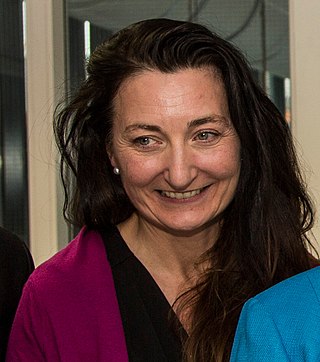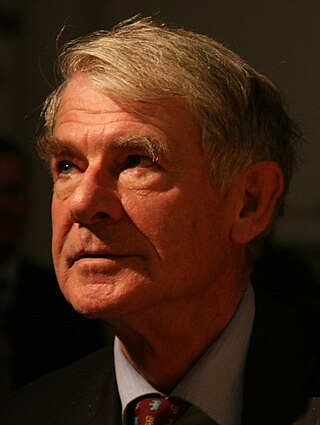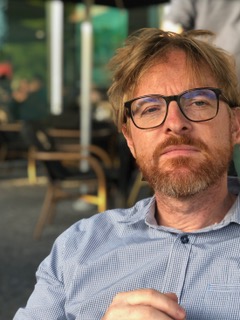Related Research Articles

The entorhinal cortex (EC) is an area of the brain's allocortex, located in the medial temporal lobe, whose functions include being a widespread network hub for memory, navigation, and the perception of time. The EC is the main interface between the hippocampus and neocortex. The EC-hippocampus system plays an important role in declarative (autobiographical/episodic/semantic) memories and in particular spatial memories including memory formation, memory consolidation, and memory optimization in sleep. The EC is also responsible for the pre-processing (familiarity) of the input signals in the reflex nictitating membrane response of classical trace conditioning; the association of impulses from the eye and the ear occurs in the entorhinal cortex.

Cognitive neuroscience is the scientific field that is concerned with the study of the biological processes and aspects that underlie cognition, with a specific focus on the neural connections in the brain which are involved in mental processes. It addresses the questions of how cognitive activities are affected or controlled by neural circuits in the brain. Cognitive neuroscience is a branch of both neuroscience and psychology, overlapping with disciplines such as behavioral neuroscience, cognitive psychology, physiological psychology and affective neuroscience. Cognitive neuroscience relies upon theories in cognitive science coupled with evidence from neurobiology, and computational modeling.

Behavioral neuroscience, also known as biological psychology, biopsychology, or psychobiology, is the application of the principles of biology to the study of physiological, genetic, and developmental mechanisms of behavior in humans and other animals.

Rodolfo Llinás Riascos is a Colombian-born American neuroscientist. He is currently the Thomas and Suzanne Murphy Professor of Neuroscience and Chairman Emeritus of the Department of Physiology & Neuroscience at the NYU School of Medicine. Llinás has published over 800 scientific articles.
A gamma wave or gamma Rhythm is a pattern of neural oscillation in humans with a frequency between 25 and 140 Hz, the 40-Hz point being of particular interest. Gamma rhythms are correlated with large scale brain network activity and cognitive phenomena such as working memory, attention, and perceptual grouping, and can be increased in amplitude via meditation or neurostimulation. Altered gamma activity has been observed in many mood and cognitive disorders such as Alzheimer's disease, epilepsy, and schizophrenia.
In the field of computational neuroscience, the theory of metastability refers to the human brain’s ability to integrate several functional parts and to produce neural oscillations in a cooperative and coordinated manner, providing the basis for conscious activity.

Neural oscillations, or brainwaves, are rhythmic or repetitive patterns of neural activity in the central nervous system. Neural tissue can generate oscillatory activity in many ways, driven either by mechanisms within individual neurons or by interactions between neurons. In individual neurons, oscillations can appear either as oscillations in membrane potential or as rhythmic patterns of action potentials, which then produce oscillatory activation of post-synaptic neurons. At the level of neural ensembles, synchronized activity of large numbers of neurons can give rise to macroscopic oscillations, which can be observed in an electroencephalogram. Oscillatory activity in groups of neurons generally arises from feedback connections between the neurons that result in the synchronization of their firing patterns. The interaction between neurons can give rise to oscillations at a different frequency than the firing frequency of individual neurons. A well-known example of macroscopic neural oscillations is alpha activity.
Recurrent thalamo-cortical resonance is an observed phenomenon of oscillatory neural activity between the thalamus and various cortical regions of the brain. It is proposed by Rodolfo Llinas and others as a theory for the integration of sensory information into the whole of perception in the brain. Thalamocortical oscillation is proposed to be a mechanism of synchronization between different cortical regions of the brain, a process known as temporal binding. This is possible through the existence of thalamocortical networks, groupings of thalamic and cortical cells that exhibit oscillatory properties.

The Moser research environment is the informal name of Kavli Institute for Systems Neuroscience at the Norwegian University of Science and Technology (NTNU) in Trondheim, Norway. The neuroscience research institute is founded and led by the Nobel laureates Edvard Moser and May-Britt Moser since 1996. The Kavli Institute for Systems Neuroscience comprises two research centres: Centre for Neural Computation (CNC), a centre of excellence since 2002; and the Egil and Pauline Braathen and Fred Kavli Centre for Cortical Microcircuits (BKC).

Edvard Ingjald Moser is a Norwegian professor of psychology and neuroscience at the Kavli Institute for Systems Neuroscience, at the Norwegian University of Science and Technology (NTNU) in Trondheim. In 2005, he and May-Britt Moser discovered grid cells in the brain's medial entorhinal cortex. Grid cells are specialized neurons that provide the brain with a coordinate system and a metric for space. In 2018, he discovered a neural network that expresses your sense of time in experiences and memories located in the brain's lateral entorhinal cortex. He shared the Nobel Prize in Physiology or Medicine in 2014 with long-term collaborator and then-wife May-Britt Moser, and previous mentor John O'Keefe for their work identifying the brain's positioning system. The two main components of the brain's GPS are; grid cells and place cells, a specialized type of neuron that respond to specific locations in space. Together with May-Britt Moser he established the Moser research environment, which they lead.

May-Britt Moser is a Norwegian psychologist and neuroscientist, who is a Professor of Psychology and Neuroscience at the Norwegian University of Science and Technology (NTNU). She and her then-husband, Edvard Moser, shared half of the 2014 Nobel Prize in Physiology or Medicine, awarded for work concerning the grid cells in the entorhinal cortex, as well as several additional space-representing cell types in the same circuit that make up the positioning system in the brain. Together with Edvard Moser she established the Moser research environment at NTNU, which they lead. Since 2012 she has headed the Centre for Neural Computation.
FieldTrip is a MATLAB software toolbox for magnetoencephalography (MEG) and electroencephalography (EEG) analysis. It is developed at the Donders Institute for Brain, Cognition and Behaviour at the Radboud University Nijmegen, together with collaborating institutes. The development of FieldTrip is supported by funding from the BrainGain, Human Connectome and ChildBrain projects. The FieldTrip software is released as open source under the GNU General Public License.
The Neurophysiological Biomarker Toolbox (NBT) is an open source MATLAB toolbox for the computation and integration of neurophysiological biomarkers. The NBT toolbox has so far been used in seven peer-reviewed research articles, and has a broad user base of more than 1000 users. The NBT toolbox provides unique features for analysis of resting-state EEG or MEG recordings. NBT offers a pipeline from data storage to statistics including artifact rejection, signal visualization, biomarker computation, statistical testing, and biomarker databasing. NBT allows for easy implementation of new biomarkers, and incorporates an online wiki that aims at facilitating collaboration among NBT users including extensive help and tutorials. The standardised way of data storage and analysis that NBT proposes allow different research projects to merge, compare, or share their data and biomarker algorithms.

John O'Keefe, is an American-British neuroscientist, psychologist and a professor at the Sainsbury Wellcome Centre for Neural Circuits and Behaviour and the Research Department of Cell and Developmental Biology at University College London. He discovered place cells in the hippocampus, and that they show a specific kind of temporal coding in the form of theta phase precession. He shared the Nobel Prize in Physiology or Medicine in 2014, together with May-Britt Moser and Edvard Moser; he has received several other awards. He has worked at University College London for his entire career, but also held a part-time chair at the Norwegian University of Science and Technology at the behest of his Norwegian collaborators, the Mosers.
Andreas Karl Engel is a German neuroscientist. He is the director of the Department of Neurophysiology and Pathophysiology at the University Medical Center Hamburg-Eppendorf (UKE).
The Department of Psychology at the University of Oslo is the oldest and largest research institute and educational institution in psychology in Norway. It is Norway's main research institution in clinical psychology, cognitive psychology, developmental psychology, personality psychology, and social and cultural psychology, and one of the main research environments in neuroscience. The institute is located in the Harald Schjelderup Building adjacent to Oslo University Hospital, Rikshospitalet in the Gaustad area of Oslo; the building is shared with parts of the Faculty of Medicine, while Oslo University Hospital occupies surrounding buildings. The institute's alumni include two Nobel laureates, Edvard Moser and May-Britt Moser.

Harold Bekkering is a Dutch professor of cognitive psychology at the Donders Institute for Brain, Cognition and Behaviour of the Radboud University Nijmegen. His research has covered many different ways of learning, ranging from basic sensorimotor learning to complex forms of social learning. Lately, he aims to implement knowledge about human learning in educational settings.

Wolf Joachim Singer is a German neurophysiologist.

Alexander T. Sack is a German neuroscientist and cognitive psychologist. He is currently appointed as a full professor and chair of applied cognitive neuroscience at the Faculty of Psychology and Neuroscience at Maastricht University. He is also co-founder and board member of the Dutch-Flemish Brain Stimulation Foundation, director of the International Clinical TMS Certification Course, co-director of the Center for Integrative Neuroscience (CIN) and the Scientific Director of the Transcranial Brain Stimulation Policlinic at Maastricht University Medical Centre.
Aslı Özyürek is a linguist, cognitive scientist and psychologist. She is professor at the Center for Language Sciences and the Donders Institute for Brain, Cognition and Behaviour at Radboud University Nijmegen, and incoming Director of the Multimodal Language Department of the Max Planck Institute for Psycholinguistics.
References
- 1 2 "Professor Ole Jensen MSc, PhD". University of Birmingham.
- ↑ "Ole Jensen's Publons profile". publons.com. Retrieved 29 June 2020.
- ↑ "Ole Jensen". University of Birmingham Memory and Learning Group. Retrieved 29 June 2020.
- ↑ "JSMF grant awarded to Ole Jensen". Radboud University. Retrieved 23 October 2020.
- ↑ "Some brain parts have to shut up for a while". Donders Institute. Retrieved 23 October 2020.
- ↑ "Brain oscillations in cognition and disorders". Neuronal Oscillations. Retrieved 29 June 2020.